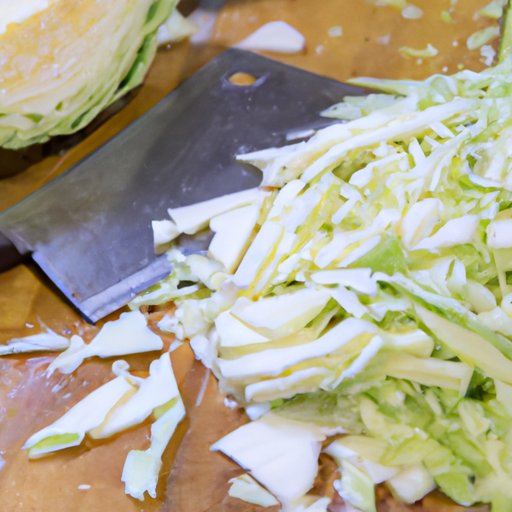I. Introduction
Cabbage is a versatile and nutrient-dense vegetable that is a staple in many cultures around the world. From salads to soups, sautés to stir fries, cabbage can be used in a variety of dishes. But to use it effectively, it’s important to know how to cut it properly. In this article, we will explore the basics of cabbage cutting and offer tips on how to cut it like a pro.
II. Cabbage Cutting Basics
There are several types of cabbage, including green, Napa, Savoy, and red cabbage. Green cabbage is the most common and versatile variety, while Napa cabbage is often used in Asian cuisine. Savoy cabbage has crinkly leaves and a milder flavor, while red cabbage is often used for pickling or as a colorful addition to salads.
When it comes to cutting cabbage, you will need a sharp knife, cutting board, and a bowl to hold the chopped cabbage. A large knife with a broad blade is best for cutting cabbage, as it will provide the leverage needed to chop through the tough leaves.
III. Master the Art of Cutting Cabbage: A Step-by-Step Guide
1. Start by removing any bruised or damaged outer leaves from the cabbage head. Rinse the cabbage under running water and pat it dry with a paper towel.
2. Place the cabbage on a cutting board with the stem facing downwards. Cut the cabbage in half lengthwise with a sharp knife.
3. Remove the stem from each cabbage half by making a v-shaped cut around it. This will create a triangular wedge in the cabbage that can be removed.
4. Cut each cabbage half in half again, making four pieces in total. Cut each quarter into thin slices, as desired.
5. Alternatively, you can use a mandoline or food processor to slice the cabbage. However, be careful when using a mandoline, as the sharp blade can be dangerous.
IV. Sharp Knives and Steady Hands: Tips for Perfectly Diced Cabbage
When it comes to dicing cabbage, it’s important to use a sharp knife and proper grip techniques. A sharp knife will allow you to make clean cuts through the cabbage, while a dull knife can cause the cabbage to bruise and tear.
To dice cabbage, start by cutting the cabbage in half and removing the stem. Cut the cabbage into thin slices and then stack them up. Cut the slices into thin strips, turn the strips horizontally and cut them into small pieces. This technique will create uniform pieces of cabbage that cook evenly.
V. 5 Different Cuts for an Endless Variety of Cabbage Dishes
Here are five different ways to cut cabbage:
1. Shredding – Cut the cabbage into thin ribbons for use in salads and slaws or as a topping for tacos and sandwiches.
2. Wedges – Cut the cabbage into large wedges for roasting or grilling.
3. Chunks – Cut the cabbage into bite-sized pieces for use in stir fries or soups.
4. Grated – Use a box grater or food processor to grate the cabbage for use in coleslaw or as a topping for tacos and burgers.
5. Leaves – Separating the cabbage leaves is ideal for use in dishes like stuffed cabbage rolls.
VI. From Slaw to Stir Fry: Cabbage Cutting Techniques Every Home Cook Needs to Know
Cabbage can be used in a variety of dishes, and the right cut can make all the difference. Use shredded cabbage in coleslaw or tacos, wedges for roasting, and chunks in stir fries and soups.
When choosing a cut for your desired dish, consider the texture and cooking time of each cut. For example, shredded cabbage will cook faster than chunked cabbage, and wedges will take longest to cook.
VII. Don’t Let Tough Cabbage Get You Down – How to Cut it Like a Pro
To make cutting tough cabbage easier, use a heavy knife with a sharp blade. A chef’s knife or a cleaver will provide the leverage needed to chop through the tough leaves.
Another tip is to core the cabbage first. Remove the outer leaves and cut out the tough core at the bottom of the cabbage. This will make it easier to slice the cabbage into smaller pieces.
VIII. Ditch the Food Processor: Efficient Hand-Cutting Methods for Cabbage
While a food processor can be useful for cutting cabbage, it can also be time-consuming to clean and can lead to uneven cuts. Hand-cutting cabbage with a sharp knife is a more efficient method that is easy to master.
To save time, try halving the cabbage and slicing it lengthwise. This will allow you to make thin slices more quickly than if you were to slice each quarter individually.
IX. Cabbage 101: The Basics of Knife Skills for the Perfect Cut
When it comes to cutting cabbage, honing your knife skills is essential for achieving the perfect cut. Here are some practical tips:
– Use a sharp knife with a broad blade.
– Use the right grip. Place your thumb and index finger on the handle and grip the blade with your other 3 fingers.
– Keep your fingers away from the blade and use a claw grip technique when holding the cabbage to prevent injuries.
X. Conclusion
Cabbage is a versatile and healthy vegetable that can be used in a variety of dishes. Whether you’re making slaw, soup, or stir fry, knowing how to cut cabbage properly can make all the difference in the outcome of your dish.
